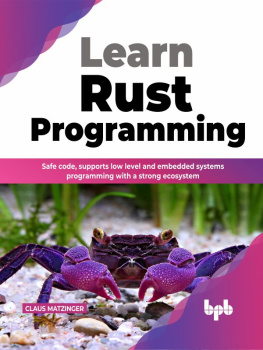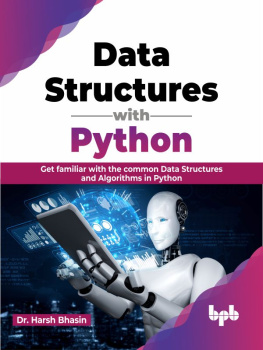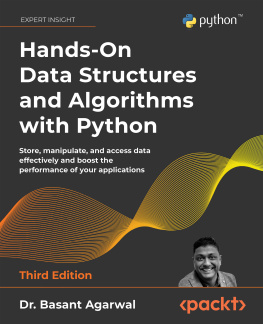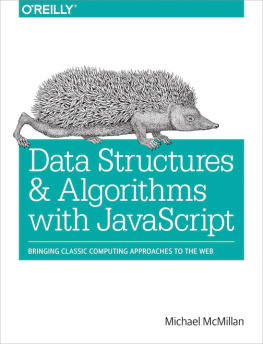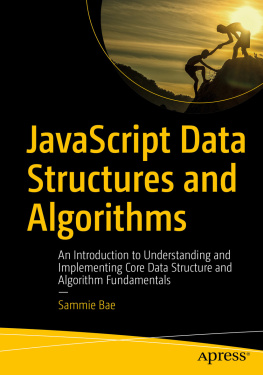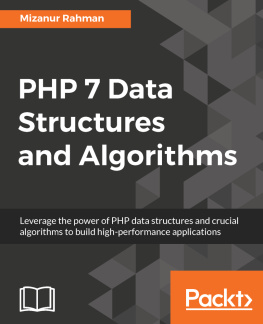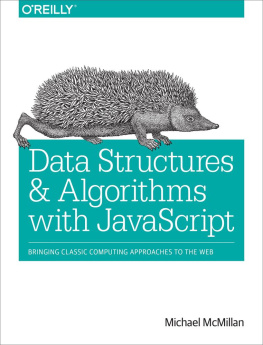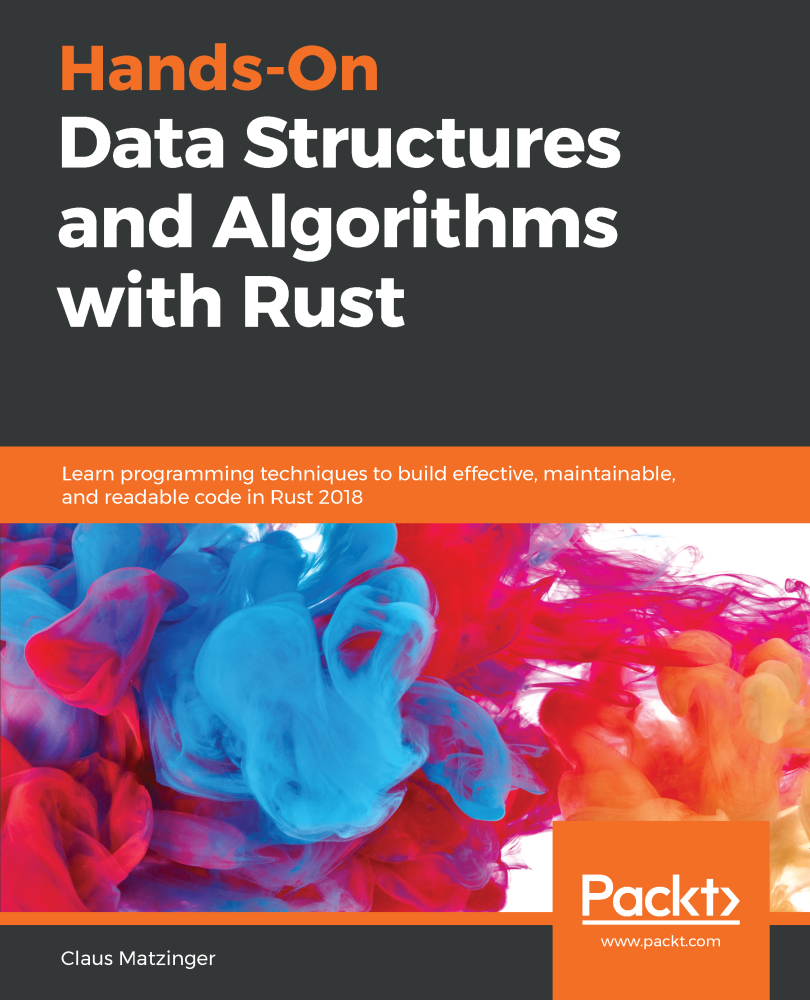
Hands-On Data Structures and Algorithms with Rust
Learn programming techniques to build effective, maintainable, and readable code in Rust 2018
Claus Matzinger

BIRMINGHAM - MUMBAI
Hands-On Data Structures and Algorithms with Rust
Copyright 2019 Packt Publishing
All rights reserved. No part of this book may be reproduced, stored in a retrieval system, or transmitted in any form or by any means, without the prior written permission of the publisher, except in the case of brief quotations embedded in critical articles or reviews.
Every effort has been made in the preparation of this book to ensure the accuracy of the information presented. However, the information contained in this book is sold without warranty, either express or implied. Neither the author(s), nor Packt Publishing or its dealers and distributors, will be held liable for any damages caused or alleged to have been caused directly or indirectly by this book.
Packt Publishing has endeavored to provide trademark information about all of the companies and products mentioned in this book by the appropriate use of capitals. However, Packt Publishing cannot guarantee the accuracy of this information.
Commissioning Editor: Richa Tripathi
Acquisition Editor: Shahnish Khan
Content Development Editor: Zeeyan Pinheiro
Technical Editor: Romy Dias
Copy Editor: Safis Editing
Project Coordinator: Vaidehi Sawant
Proofreader: Safis Editing
Indexer: Priyanka Dhadke
Graphics: Alishon Mendonsa
Production Coordinator: Tom Scaria
First published: January 2019
Production reference: 1230119
Published by Packt Publishing Ltd.
Livery Place
35 Livery Street
Birmingham
B3 2PB, UK.
ISBN 978-1-78899-552-8
www.packtpub.com
mapt.io
Mapt is an online digital library that gives you full access to over 5,000 books and videos, as well as industry leading tools to help you plan your personal development and advance your career. For more information, please visit our website.
Why subscribe?
Spend less time learning and more time coding with practical eBooks and Videos from over 4,000 industry professionals
Improve your learning with Skill Plans built especially for you
Get a free eBook or video every month
Mapt is fully searchable
Copy and paste, print, and bookmark content
Packt.com
Did you know that Packt offers eBook versions of every book published, with PDF and ePub files available? You can upgrade to the eBook version at www.packt.com and as a print book customer, you are entitled to a discount on the eBook copy. Get in touch with us at customercare@packtpub.com for more details.
At www.packt.com , you can also read a collection of free technical articles, sign up for a range of free newsletters, and receive exclusive discounts and offers on Packt books and eBooks.
Foreword
Rust is not an easy language to learn. Ask why, and you'll hear that Rust was designed to solve almost any complex problem in system programming, a complicated domain to begin with. It was designed to do it safely, to be incredibly fast, and be very strict; "ease of use" is a necessary sacrifice. Rust reads like any other imperative language, but it incorporates a number of special concepts that ask you to think through your problems in greater depth and with a different spin than you're used to. It's brutally honest about the complicated parts a system language has to address.
Those are the typical reasons cited for why Rust is hard. The more honest answer is that those people may not have the right teacher.
I met Claus at my first event as an open source developer for Microsoft. He had joined just a few months before, and could show me the ropes. It didn't occur to me until a few weeks later that, as his manager, I was supposed to be teaching him! I've discovered that this is a common situation for Claus: he falls naturally into a teaching role. Not a lecturing bore, eitherthe kind of teaching where the student doesn't realize that's what's happening until they find themselves using newly acquired knowledge. We've long since moved into other roles, but I've seen the pattern repeated over and over again.
Early in his career as an open source developer, Claus found himself diving deep into documentation. And fair enough: it's often the most important part of a project! "Just three lines," he said to me once. "I just lost a whole day of my life because someone didn't bother to write three lines of good documentation. I can fix that."
Claus's background was in academic software development, but in his professional life, he has rejected the dry, abstract computer science theory often taught in that environment. He is one of those rare developers who cares deeply about making this easy for people to understand. It's important that it makes sense, it's important that it looks nice, it's important that it's easy to followand how to make it that way is intuitive to him. I think it honestly doesn't occur to him that other people struggle to explain things the way he does naturally.
One of the aspects of this book that I appreciated the most when reading it is the balance Claus strikes. It stays focused on the teaching goal without getting sidetracked by more technical detail than is required. We all know the feeling of reading that kind of documentationthe kind that demands to be skimmed. Most readers, including myself, are simply confused by too much theory or detail at the outset. As Claus puts it, "most teachers make it sound like something really fancy is going on, but, in reality, it's quite simple."
This practical approach has made Claus an in-demand speaker, community member, and contributor in the Rust world. This book is his next step into teaching for a broader audience, and I'm excited to see its impact.
You've chosen a great teacher! Rust is difficult to learn, but it doesn't have to be. Just ask Claus.
Campbell Vertesi
Principal Software Engineer Manager
twitter: @ohthehugemanatee
ohthehugemanatee.org
Contributors
About the author
Claus Matzinger is a software engineer with a very diverse background. After working in a small company maintaining code for embedded devices, he joined a large corporation to work on legacy Smalltalk applications. This led to a great interest in programming languages early on, and Claus became the CTO for a health games start-up based on Scala technology.
Since then, Claus' roles have shifted toward customer-facing roles in the IoT database-technology start-up crate.io and, most recently, Microsoft. There, he hosts a podcast, writes code together with customers, and blogs about the solutions arising from these engagements. For more than 5 years, Claus has implemented software to help customers innovate, achieve, and maintain success.
Next page

